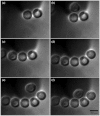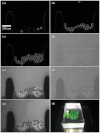High-throughput optofluidic system for the laser microsurgery of oocytes
- PMID: 22352645
- PMCID: PMC3380719
- DOI: 10.1117/1.JBO.17.1.015001
High-throughput optofluidic system for the laser microsurgery of oocytes
Abstract
This study combines microfluidics with optical microablation in a microscopy system that allows for high-throughput manipulation of oocytes, automated media exchange, and long-term oocyte observation. The microfluidic component of the system transports oocytes from an inlet port into multiple flow channels. Within each channel, oocytes are confined against a microfluidic barrier using a steady fluid flow provided by an external computer-controlled syringe pump. This allows for easy media replacement without disturbing the oocyte location. The microfluidic and optical-laser microbeam ablation capabilities of the system were validated using surf clam (Spisula solidissima) oocytes that were immobilized in order to permit ablation of the 5 μm diameter nucleolinus within the oocyte nucleolus. Oocytes were the followed and assayed for polar body ejection.
Figures





Similar articles
-
Composition and dynamics of the nucleolinus, a link between the nucleolus and cell division apparatus in surf clam (Spisula) oocytes.J Biol Chem. 2012 Feb 24;287(9):6702-13. doi: 10.1074/jbc.M111.288506. Epub 2012 Jan 4. J Biol Chem. 2012. PMID: 22219192 Free PMC article.
-
Rediscovery of the nucleolinus, a dynamic RNA-rich organelle associated with the nucleolus, spindle, and centrosomes.Proc Natl Acad Sci U S A. 2010 Aug 3;107(31):13718-23. doi: 10.1073/pnas.1008469107. Epub 2010 Jul 19. Proc Natl Acad Sci U S A. 2010. PMID: 20643950 Free PMC article.
-
Centrosomal RNA correlates with intron-poor nuclear genes in Spisula oocytes.Proc Natl Acad Sci U S A. 2008 May 13;105(19):6993-7. doi: 10.1073/pnas.0802293105. Epub 2008 May 5. Proc Natl Acad Sci U S A. 2008. PMID: 18458332 Free PMC article.
-
Micro-optics for microfluidic analytical applications.Chem Soc Rev. 2018 Feb 19;47(4):1391-1458. doi: 10.1039/c5cs00649j. Chem Soc Rev. 2018. PMID: 29308474 Review.
-
Microfluidic cell chips for high-throughput drug screening.Bioanalysis. 2016 May;8(9):921-37. doi: 10.4155/bio-2016-0028. Epub 2016 Apr 13. Bioanalysis. 2016. PMID: 27071838 Free PMC article. Review.
Cited by
-
Mapping optical path length and image enhancement using quantitative orientation-independent differential interference contrast microscopy.J Biomed Opt. 2017 Jan 1;22(1):16006. doi: 10.1117/1.JBO.22.1.016006. J Biomed Opt. 2017. PMID: 28060991 Free PMC article.
-
Optofluidic cell manipulation for a biological microbeam.Rev Sci Instrum. 2013 Jan;84(1):014301. doi: 10.1063/1.4774043. Rev Sci Instrum. 2013. PMID: 23387672 Free PMC article.

